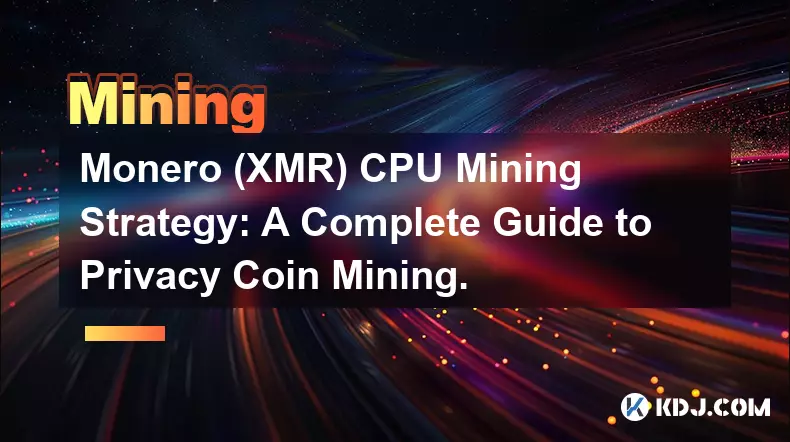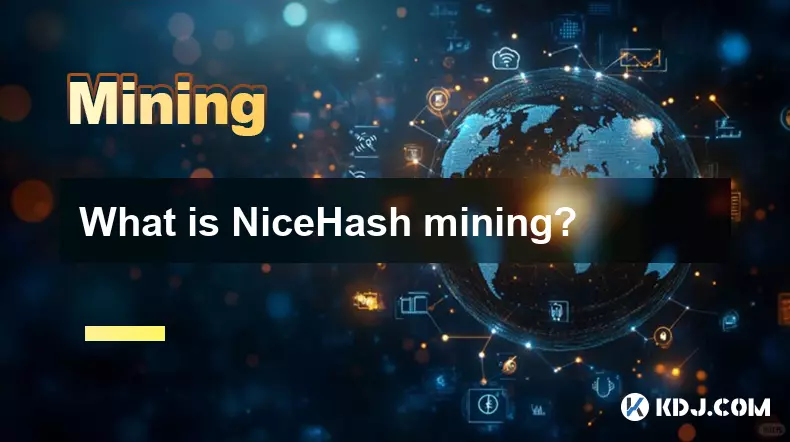-
 bitcoin
bitcoin $103128.103252 USD
-3.33% -
 ethereum
ethereum $3437.127692 USD
-4.86% -
 tether
tether $0.999700 USD
-0.02% -
 xrp
xrp $2.403993 USD
-5.73% -
 bnb
bnb $961.374676 USD
-4.11% -
 solana
solana $154.938665 USD
-8.18% -
 usd-coin
usd-coin $1.000113 USD
0.03% -
 tron
tron $0.298122 USD
0.30% -
 dogecoin
dogecoin $0.172428 USD
-5.76% -
 cardano
cardano $0.557625 USD
-7.13% -
 hyperliquid
hyperliquid $38.740701 USD
-6.51% -
 chainlink
chainlink $15.306051 USD
-7.51% -
 bitcoin-cash
bitcoin-cash $507.558648 USD
-3.26% -
 stellar
stellar $0.281899 USD
-6.74% -
 unus-sed-leo
unus-sed-leo $9.241811 USD
0.57%
Monero (XMR) CPU Mining Strategy: A Complete Guide to Privacy Coin Mining.
Monero’s CPU-friendly RandomX algorithm promotes decentralized mining, allowing users to profitably mine with consumer hardware while prioritizing privacy and security.
Nov 03, 2025 at 12:54 pm

Understanding Monero and Its Unique Mining Mechanism
1. Monero (XMR) is a privacy-focused cryptocurrency that utilizes the CryptoNight algorithm, specifically designed to be resistant to ASIC mining hardware. This allows regular users with consumer-grade CPUs to participate in mining without being outcompeted by large-scale industrial operations.
2. Unlike Bitcoin, which relies on transparent blockchain records, Monero employs ring signatures, stealth addresses, and confidential transactions to obscure sender, receiver, and transaction amount information. This emphasis on privacy has cultivated a dedicated community of users and miners who value financial anonymity.
3. The network adjusts its mining difficulty dynamically based on the total hash rate, ensuring consistent block times even as more miners join or leave the network. This adaptability makes CPU mining viable over long periods, especially during times when GPU or ASIC-based coins become too competitive.
4. Because Monero’s proof-of-work algorithm favors memory-hard computations, it levels the playing field between different types of hardware. CPUs, particularly those with strong multi-threading capabilities like AMD Ryzen processors, can perform competitively against GPUs in this environment.
5. Regular protocol updates, such as the transition from CryptoNight to RandomX in 2019, have reinforced Monero’s commitment to decentralization by optimizing the mining process for general-purpose hardware and further deterring specialized mining rigs.
Setting Up an Efficient CPU Mining Environment
1. Choose a modern CPU with high core count and robust cache performance. Processors like the AMD Ryzen 9 series or Intel Core i7/i9 models deliver strong results due to their superior instruction throughput and memory bandwidth, both critical for RandomX efficiency.
2. Install a lightweight operating system such as Ubuntu Server or Windows 10/11 with minimal background processes. Reducing system overhead ensures maximum resources are allocated to mining operations, improving overall hash rate stability.
3. Download a reliable Monero mining software such as XMRig, an open-source miner actively maintained by the community. XMRig supports advanced configuration options including CPU thread allocation, power management settings, and remote monitoring via API.
4. Configure the miner using optimized settings tailored to your specific CPU model. For example, enabling large pages support can boost performance by up to 20%, while fine-tuning the number of threads prevents overheating and throttling.
5. Join a reputable mining pool such as MineXMR, SupportXMR, or HashVault. Pool mining increases the frequency of reward payouts by combining computational power with other miners, making income more predictable compared to solo mining.
Optimizing Performance and Managing Operational Costs
1. Monitor CPU temperature closely using tools like HWMonitor or Core Temp. Sustained mining loads generate significant heat, and maintaining temperatures below 80°C helps prevent thermal throttling and extends hardware lifespan.
2. Use undervolting techniques to reduce power consumption without sacrificing much performance. Adjusting voltage curves in BIOS or through software like ThrottleStop can lead to substantial energy savings, directly increasing net profitability.
3. Evaluate electricity costs relative to expected earnings. In regions with high energy prices, continuous mining may result in negative returns. Use online calculators to estimate daily profit based on current XMR price, hash rate, and kilowatt-hour cost.
4. Schedule mining sessions during off-peak hours if time-of-use billing applies. Running the rig when electricity rates are lowest improves margin, especially when combined with automated scripts that start and stop the miner accordingly.
5. Consider repurposing waste heat in colder climates. The thermal output from sustained CPU usage can supplement home heating systems, effectively turning part of the electricity expense into a dual-purpose investment.
Security Practices for Monero Miners
1. Always download mining software from official repositories or verified sources. Fake or modified versions of XMRig have been known to include malware that steals wallets or hijacks system resources for unauthorized purposes.
2. Use a unique wallet address for each mining operation to minimize exposure in case of a security breach. Generate addresses using the official Monero GUI wallet or CLI tools, ensuring private keys remain offline and protected.
3. Enable firewall rules to restrict outbound connections only to trusted mining pool servers. This reduces the risk of data exfiltration or command-and-control communication from potential intrusions.
4. Regularly update all software components, including the OS, drivers, and mining application. Security patches often close vulnerabilities that could otherwise be exploited by remote attackers targeting always-on mining rigs.
5. Avoid mining on shared or work-provided devices. Unauthorized use of institutional hardware violates most acceptable usage policies and may lead to disciplinary action or legal consequences.
Frequently Asked Questions
What is the average hash rate I can expect from a consumer CPU?Modern CPUs typically achieve between 2,000 and 6,000 H/s depending on architecture and optimization. For instance, an AMD Ryzen 9 5900X can reach approximately 5,500 H/s under optimal conditions using XMRig with large pages enabled.
Can I mine Monero using a laptop?While technically possible, mining on laptops is generally discouraged due to limited cooling capacity and higher power consumption relative to performance. Prolonged use under full load can cause permanent hardware damage or reduced battery life.
Is cloud CPU mining profitable for Monero?Most cloud computing providers charge rates that exceed potential Monero earnings, especially after accounting for instance startup delays and fluctuating market prices. Self-hosted mining usually offers better control and long-term viability.
How often are Monero blocks found?The Monero network targets a new block every two minutes. With thousands of miners contributing globally, individual success depends on hash share within a pool, leading to frequent micro-payouts rather than sporadic large rewards.
Disclaimer:info@kdj.com
The information provided is not trading advice. kdj.com does not assume any responsibility for any investments made based on the information provided in this article. Cryptocurrencies are highly volatile and it is highly recommended that you invest with caution after thorough research!
If you believe that the content used on this website infringes your copyright, please contact us immediately (info@kdj.com) and we will delete it promptly.
- DESK Token, Tokenized Real Estate, and Venture Hub: A New Era in Digital Assets
- 2025-11-12 16:55:02
- XNO, BTC, Decred: Navigating Crypto Tides with Nano's Surge and Decred's Dip
- 2025-11-12 14:40:01
- BONK Price Swings: Insider Trading Whispers and the Meme Coin Rollercoaster
- 2025-11-12 15:05:01
- Ethereum, Altcoins, and Long-Term Gains: Navigating the Crypto Landscape
- 2025-11-12 09:00:00
- Strategy Shares, Bitcoin Retreat, and Market Pain: A NYC Perspective
- 2025-11-12 08:55:01
- Taft, Veterans, and Salutes: A Presidential Honor
- 2025-11-12 09:00:00
Related knowledge

What is the block reward in mining?
Nov 06,2025 at 12:35am
Understanding Block Rewards in Cryptocurrency Mining1. The block reward is the incentive miners receive for successfully validating and adding a new b...

How do mining algorithms work?
Nov 06,2025 at 04:59am
Mining Algorithms and Their Role in Blockchain Networks1. Mining algorithms serve as the backbone of blockchain consensus mechanisms, ensuring that tr...

What is NiceHash mining?
Nov 06,2025 at 07:40am
NiceHash mining refers to the process of renting out computational power to individuals or organizations seeking to mine cryptocurrencies without owni...

Does an antivirus program affect mining?
Nov 05,2025 at 09:29pm
Understanding Decentralized Exchanges in the Crypto Ecosystem1. Decentralized exchanges (DEXs) operate without a central authority, allowing users to ...

What is the history of Bitcoin mining?
Nov 05,2025 at 08:15pm
Within the fast-moving world of cryptocurrency, new developments emerge daily, reshaping how investors, developers, and institutions interact with dig...

How is the energy consumption of mining justified?
Nov 05,2025 at 10:20pm
Energy Consumption in Cryptocurrency Mining1. The energy consumption associated with cryptocurrency mining has drawn significant attention from enviro...

What is the block reward in mining?
Nov 06,2025 at 12:35am
Understanding Block Rewards in Cryptocurrency Mining1. The block reward is the incentive miners receive for successfully validating and adding a new b...

How do mining algorithms work?
Nov 06,2025 at 04:59am
Mining Algorithms and Their Role in Blockchain Networks1. Mining algorithms serve as the backbone of blockchain consensus mechanisms, ensuring that tr...

What is NiceHash mining?
Nov 06,2025 at 07:40am
NiceHash mining refers to the process of renting out computational power to individuals or organizations seeking to mine cryptocurrencies without owni...

Does an antivirus program affect mining?
Nov 05,2025 at 09:29pm
Understanding Decentralized Exchanges in the Crypto Ecosystem1. Decentralized exchanges (DEXs) operate without a central authority, allowing users to ...

What is the history of Bitcoin mining?
Nov 05,2025 at 08:15pm
Within the fast-moving world of cryptocurrency, new developments emerge daily, reshaping how investors, developers, and institutions interact with dig...

How is the energy consumption of mining justified?
Nov 05,2025 at 10:20pm
Energy Consumption in Cryptocurrency Mining1. The energy consumption associated with cryptocurrency mining has drawn significant attention from enviro...
See all articles


























![[4K 60fps] no care by crashpancake2 (1 Coin) [4K 60fps] no care by crashpancake2 (1 Coin)](/uploads/2025/11/12/cryptocurrencies-news/videos/6913a8862890b_image_500_375.webp)














































